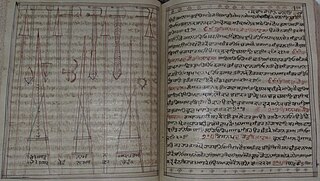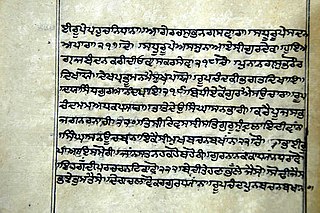
The Guru Granth Sahib is the central holy religious scripture of Sikhism, regarded by Sikhs as the final, sovereign and eternal Guru following the lineage of the ten human gurus of the religion. The Adi Granth, its first rendition, was compiled by the fifth guru, Guru Arjan (1564–1606). Its compilation was completed on 29 August 1604 and first installed inside the Golden Temple in Amritsar on 1 September 1604. Baba Buddha was appointed the first Granthi of the Golden Temple. Shortly afterwards Guru Hargobind added Ramkali Ki Vaar. Later, Guru Gobind Singh, the tenth Sikh guru, added hymns of Guru Tegh Bahadur to the Adi Granth and affirmed the text as his successor. This second rendition became known as the Guru Granth Sahib and is also sometimes referred to as the Adi Granth.

The Dasam Granth is a collection of various poetic compositions attributed to Guru Gobind Singh. The text enjoyed an equal status with the Adi Granth, or Guru Granth Sahib, in the eighteenth and nineteenth centuries and were installed side by side on the same platform. The Dasam Granth lost favor during the colonial period when reformist Singh Sabha Movement scholars couldn't contextualize the reworkings of Puranic stories or the vast collection of 'Tales of Deceit' Sri Charitropakhyan.

The Sarbloh Granth or Sarabloh Granth, also called Manglacharan Puran or Sri Manglacharan Ji, is a voluminous scripture, composed of more than 6,500 poetic stanzas. It is traditionally attributed as being the work of Guru Gobind Singh, the tenth Sikh guru. Scholars, on the other hand, attribute the work to after the Guru's death, being authored by an unknown poet. The work is mostly revered by the Nihang sect.

Panj Pyare refers to a gathered ad hoc quintet of five baptised (Amritdhari) Khalsa Sikhs who act as institutionalized leaders for the wider Sikh community.

Bhai Mani Singh was an 18th-century Sikh scholar and martyr. He was a childhood companion of Guru Gobind Singh and took the vows of Sikhism when the Guru inaugurated the Khalsa in March 1699. Soon after that, the Guru sent him to Amritsar to take charge of Harmandir Sahib, which had been without a custodian since 1696. He took control and steered the course of Sikh destiny at a critical stage in Sikh history. He was also a teacher of the Gianian Bunga, later becoming known as the "Amritsari Taksal", currently located in Sato Ki Gali.

The principal Sikh scripture is the Adi Granth, more commonly called the Guru Granth Sahib. The second most important scripture of the Sikhs is the Dasam Granth. Both of these consist of text which was written or authorised by the Sikh Gurus.

The Janamsakhis, are popular hagiographies of Guru Nanak, the founder of Sikhism. Considered by scholars as semi-legendary biographies, they were based on a Sikh oral tradition of historical fact, homily, and legend, with the first janamsakhi were composed between 50 and 80 years after his death. Many more were written in the 17th and 18th century. The largest Guru Nanak Prakash, with about 9,700 verses, was written in the early 19th century by Kavi Santokh Singh.

Varan Bhai Gurdas, also known as Varan Gyan Ratnavali, is the name given to the 40 vars which is traditionally attributed to Bhai Gurdas.

Suraj Prakash, also called Gurpartāp Sūraj Granth, is a popular and monumental hagiographic text about Sikh Gurus written by Kavi Santokh Singh (1787–1843) and published in 1843 CE. It consists of life legends performed by Sikh Gurus and historic Sikhs such as Baba Banda Bahadur in 51,820 verses. Most modern writing on the Sikh gurus finds its basis from this text.

A Hukamnama, in modern-times, refers to a hymn from the Guru Granth Sahib which is given as an injunction, order, or edict to Sikhs. It also refers to edicts issued by the contemporary Takhts. In the historical sense, it was used to refer to an issued commandment, instruction, injunction, order, or edict given by one of the Gurus of Sikhism or their officiated followers and associates during their lives.

Ratan Singh Bhangu was a Sikh historian and Nihang who wrote about the Sikhs' struggles and rise to power in North India, in his book Prachin Panth Prakash. This work describes how the Sikh people came to dominate Punjab in the 1700s and remains one of the few historical accounts of the era.

Bhai Tara Singh Wan was an eighteenth-century Sikh martyr. He was from the village of Wan, also known as Wan Tara Singh and Dall-Wan now in Tarn Taran district tehsil Bhikhiwind of the Eastern Punjab.

Twarikh Guru Khalsa is a historical book of the Sikhs from their origin to the time when they lost the Punjab to the British. The author of the book is Giani Gian Singh.

Kavi Santokh Singh was a Sikh historian, poet and writer. He was such a prolific writer that the Sikh Reference Library at Darbar Sahib Amritsar was named after him, located within the Mahakavi Santokh Singh Hall. In addition to "Great Poet" (Mahākavī) Santokh Singh was also referred to as the Ferdowsi of Punjabi literature, Ferdowsi wrote ~50,000 verses while Santokh Singh's Suraj Prakash totals ~52,000. Other scholars have thought of Santokh Singh as akin to Vyasa. Gottlieb Wilhelm Leitner in 1883 wrote that, "Santokh Singh of Kantal in the Karnal District, has rendered his name immortal" through the production of his works.

Giani Gian Singh was a 19th-century Sikh historian, literati, hagiographer, martial artist, theologian, and scholar. He wrote the works NaveenPanth Prakash and Twarikh Guru Khalsa.

Anandpur Lipi is a calligraphic style of the Gurmukhi script associated with Guru Gobind Singh. It is commonly found among early manuscripts of the Dasam Granth scripture as the employed script.

A Sikh state is a political entity that is ruled by Sikhs. There were various Sikh states, empires, and dynasties, beginning with the first Sikh state established by Banda Singh Bahadur to the Sikh-ruled princely states of British India.
Lakhpat Rai was the brother of Jaspat Rai and an enemy of the Sikhs. Lakhpat was the revenue minister of Lahore and wanted to take revenge on the Sikhs. He convinced the Mughal governor to take action against the Sikhs. Yahya Khan helped him in a large scale massacre of Sikhs called the Chhota Ghallughara, in which an estimated 7,000 Sikhs were killed. However, Purnima Dhavan gives a smaller figure of 400 Sikhs being killed in the massacre. As per Rattan Singh Bhangu's Panth Prakash, Lakhpat Rai specifically sought out copies of the Guru Granth Sahib in-order to destroy them. He was later killed by the Sikhs. His son, Dalpat Rai, sought asylum in Jammu State and settled there.

Sri Gur Sobha, also known as Sri Gur Sobha Granth, is a poetic literary work written by the court-poet Sainapati that covers the life of Guru Gobind Singh and the establishment of the Khalsa order. It is one of the Gurbilases. The overarching motif of the work consists of praise of the tenth guru.

The Gurbilas literature, or Gurbilases, refers to a genre of Sikh chronicle literature that records the biographies and historical narrations of the sixth and tenth Sikh gurus, namely Guru Hargobind and Guru Gobind Singh. They are similar to the Janamsakhi literature that contains biographies on the life of Guru Nanak. All of the main Gurbilas texts are traditionally attributed to the 18th century but their dates of completion are contested by scholars, who date them variously.



















